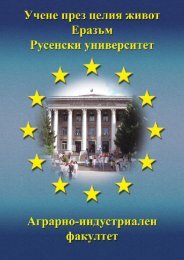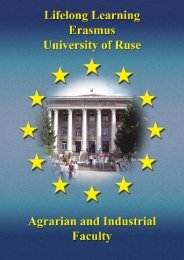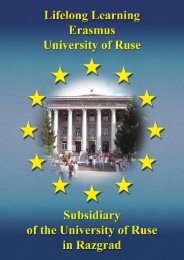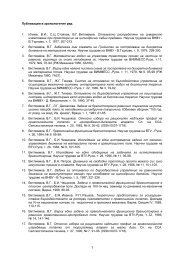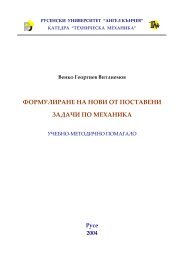Erasmus ECTS Information Package
Erasmus ECTS Information Package
Erasmus ECTS Information Package
You also want an ePaper? Increase the reach of your titles
YUMPU automatically turns print PDFs into web optimized ePapers that Google loves.
<strong>Erasmus</strong> <strong>ECTS</strong> <strong>Information</strong> <strong>Package</strong><br />
Faculty of EEEA<br />
3128 Computer Vision<br />
<strong>ECTS</strong> credits: 4<br />
Weekly classes: 2lec+0sem+0labs+2ps<br />
Assessment: continuous assessment<br />
Type of exam: written<br />
Department involved:<br />
Department of Automatics and Mechatronics<br />
Faculty of Electrical Engineering, Electronics and Automation<br />
Lecturers:<br />
Prof. Miroluyb Ivanov Mladenov, MEng, PhD, Dept. of Automatics and Mechatronics,<br />
tel.: 888 747, E-mail: mladenov@uni-ruse.bg<br />
Abstract:<br />
The course aims at giving the students working knowledge of modern computer vision systems, their basic<br />
characteristics as well as the main stages of digital image processing. The students study different problems,<br />
related to the acquisition and representation of images, image pre-processing, segmentation, image description<br />
and image recognition.<br />
Course content:<br />
Computer vision system (CVS) structure. Representation of images. Image types and models. Image geometry.<br />
Optical transformations. Stereo images. Pre-processing of images. Image filtering and coding. Morphological<br />
transformations. Histogram analysis. Image analysis. Object representation by morphological features, contours,<br />
homogeneous zones, projections and skeletons. Image segmentation. Contour segmentation, homogeneous<br />
segmentation and segmentation by neighborhood criteria. Colour image analysis. Colour models, colour models<br />
transformation. Image recognition in CVS. Basic methods and principles used in CVS. Application of CVS in<br />
communication systems.<br />
Teaching and assessment:<br />
Lectures introduce the main theoretic material using multimedia presentation and illustrate it with appropriate<br />
example problems. Lecture materials are given out in advance to the students on CD. Practice sessions are held<br />
in a computer laboratory where students use specialized program systems. They are provided with appropriate<br />
instruction materials. The final mark is formed on the basis of two written exams during the semester and on the<br />
basis of the results from the practical sessions.<br />
1530 Multimedia Systems and Technologies<br />
<strong>ECTS</strong> credits: 4<br />
Weekly classes: 2lec+0sem+0labs+1ps+2cw<br />
Assessment: continuous assessment<br />
Type of exam: written<br />
Department involved:<br />
Department of Computing, Faculty of Electrical Engineering, Electronics and Automation<br />
Lecturers:<br />
Assoc. Prof. Tsvetozar Stefanov Georgiev, MEng, PhD, Dept. of Computing, tel.: 888 827,<br />
E-mail: TGeorgiev@ecs.uni-ruse.bg<br />
Principal Assistant Professor Svetlin Nedelchev Stoyanov, MEng, Dept. Telecommunications, tel.: 888 734,<br />
E-mail: sstoyanov@ecs.uni-ruse.bg<br />
Abstract:<br />
The objective of the Multimedia Systems and Technologies course is to familiarise students with the technology of<br />
creating multimedia products, comprising text, graphic, audio and video objects according to a scenario prepared<br />
in advance, as well as with the structure of the systems for developing and recreating such products. The course<br />
examines basic graphic, sound and video file formats and compression methods and the use of some popular<br />
authoring systems. Course prerequisites include Programming Languages, Web Design, Computer Peripherals,<br />
and a course co-requisite is Program Technologies for Internet.<br />
Course content:<br />
Multimedia – history, definitions, application area. Technology of creating multimedia products. Systems for<br />
developing multimedia products. Methods and tools for creating, editing and saving text objects. Methods and<br />
tools for creating, compressing, editing and saving graphic objects. Methods and tools for creating, compressing,<br />
editing and saving audio objects. Methods and tools for creating, compressing, editing and saving video objects.<br />
Assembling, testing and distributing multimedia applications. Video-conferencing systems. Virtual reality.<br />
Teaching and assessment:<br />
Lectures familiarise students with the main theoretic aspects of creating multimedia products. Practice sessions<br />
allow each student to develop multimedia objects and integrate them in a multimedia product following a given<br />
scenario. Students have to develop a multimedia course project based on a given task. Assessment is continuous.<br />
The final mark is an average of the marks of two tests, student participation in class and the mark of the course<br />
project.<br />
204



